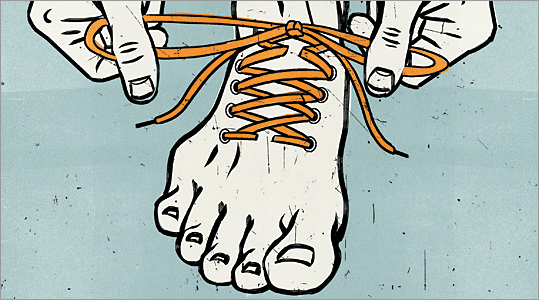Tomorrow's marathoners who have suffered foot and knee injuries should ask: Is the problem their body or their shoes?

I'd been plagued by running injuries my entire adult life. I'd seen the best sports-medicine physicians and podiatrists in the country, and they'd all prescribed the same fruitless formula of orthotics, ice, and injections. Nothing and no one could cure me. So a few years ago, I looked elsewhere: to a tiny tribe of super-athletes in Mexico, who taught me that it's not running that's dangerous -- it's running shoes.
That's right. Running shoes are a failed experiment. After nearly four decades of technological gimmicks and outrageous prices, they simply do not perform the function that's their only reason for existence -- protecting your feet. You can now buy running shoes with steel bedsprings embedded in the soles or with microchips that adjust the cushioning, but the injury rate hasn't decreased in almost 40 years. It's actually inched up; Achilles' tendon problems have risen by 10 percent since the '70s.
Some researchers suggest that running shoes actually cause the very injuries they're supposed to prevent. That idea has been out there for more than a decade, but it's gaining force, thanks to the work of Daniel Lieberman, a professor of anthropology at Harvard University who's been studying the biomechanics of the foot and the evolution of human running. Before the invention of the modern running shoe, runners couldn't land on their heels -- it was simply too painful. Doing so in today's shoes leads to excessive foot rolling, known as overpronation.
"A lot of foot and knee injuries that are currently plaguing us are actually caused by people running with shoes that actually make our feet weak, cause us to overpronate, give us knee problems," Lieberman said on Australian radio last year. "Until 1972, when the modern athletic shoe was invented by
So what are runners to do? The answer seems clearer than ever: Go barefoot, or as close to it as possible. This revelation dawned on me shortly after I came across an odd photo in a Mexican magazine. It showed a man in a skirt tearing down a rocky trail, sandals on his feet and a grin on his face. He was a Tarahumara Indian, a member of a tribe that runs
150-mile races for fun.
So how do the Tarahumara, running in shoes that barely qualify as shoes, do it? Three years ago, I trekked into the Copper Canyons of Mexico in search of the secret. And once I learned how to run barefoot-style -- landing on the balls of the feet, while keeping my feet directly under my hips -- like the Tarahumara, my ailments suddenly disappeared. Plantar fasciitis, Achilles tendinitis, sore knees -- all gone. Today, I wear something similar to a rubber glove for the foot (it has the thinnest of soles to guard against abrasions), and I haven't looked back.
It wasn't a miracle, as Lieberman would explain; it was simple mechanics. He's convinced our problems began the day we tried to outthink nature and encased our feet in motion-controlling sneakers. Others agree. Gerard Hartmann, a physical therapist in Ireland who works with world record holder Paula Radcliffe and who is himself a Nike consultant, conceded years ago that deconditioned foot muscles were the biggest factor in injuries. He likened running shoes to a plaster cast that causes our feet to atrophy.
Shoe companies and podiatrists will explain the need for specially designed shoes by going on and on about the constant pounding on the foot and the benefits of support and cushion.
"We're not all built the same way, so for certain feet, a guidance system can be very beneficial," says Washington, D.C.-based Dr. Stephen Pribut, a former president of the American Academy of Podiatric Sports Medicine and a member of the board of advisers for Runner's World magazine. "Basic structural biomechanics will not be altered by shoes."
But the unmistakable fact is that there's a trend across the shoe industry toward creating more "minimal" shoes -- those intended to duplicate the experience of, you guessed it, running barefoot. Still, those models just aren't simple enough.
Maybe it's time all of the shoe manufacturers run with the Tarahumara, too.
Christopher McDougall, a writer for Men's Health magazine, is the author of the new book Born to Run: A Hidden Tribe, Superathletes, and the Greatest Race the World Has Never Seen. Send comments to magazine@globe.com.![]()
No comments:
Post a Comment